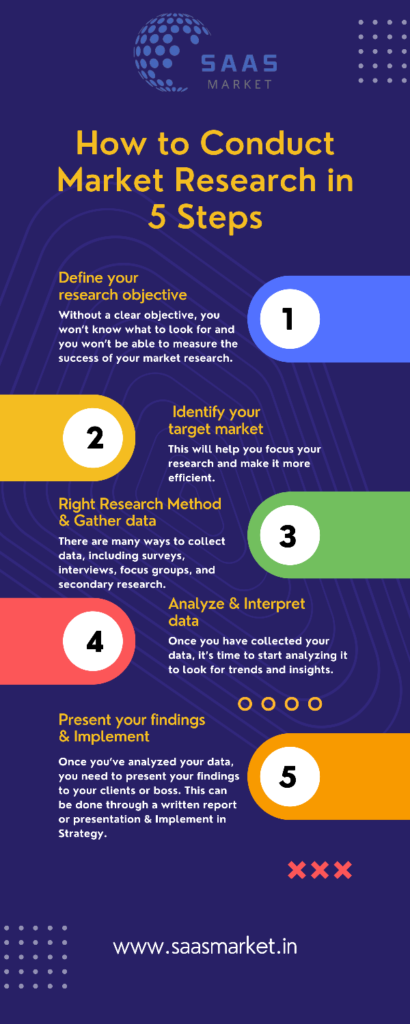In the dynamic landscape of business, mastering the art of market research process is essential for sustained growth.
Whether you operate in the B2B (Marketing Strategy) or B2C space, understanding and implementing an effective market research process can be a game-changer.
This comprehensive guide takes you through a step-by-step approach, shedding light on key strategies that will elevate your market research scope.
Introduction: Unveiling the Importance of Market Research Process
Before delving into the intricate steps, let’s understand why market research is crucial for businesses of all sizes.
Whether you’re a B2B enterprise or catering directly to consumers, gaining strategic insights through market research forms the bedrock of informed decision-making.
Understanding market trends, consumer behavior, and competitive landscapes empowers businesses to make informed decisions.
These insights guide Product Development, Marketing Strategies (b2b), and overall Business Planning.
Whether you’re a B2B enterprise navigating industry shifts or a B2C company responding to dynamic consumer preferences!
Strategic insights are the compass that directs your business towards sustainable growth. Harnessing these insights not only enhances competitiveness but also ensures agility and relevance in an ever-changing market.
Step 1: Defining Your Market Research Objectives
The first step in mastering market research is clearly defining your objectives.
For B2B businesses, this may involve understanding the competitive landscape and identifying niche opportunities.
On the other hand, B2C enterprises might focus on consumer behavior and preferences.
Ways of focusing Consumer Behavior
Understanding consumer behavior and preferences is pivotal for business success.
- By delving into the intricacies of what drives consumers, businesses can tailor products and services to meet their needs effectively.
- Employing data analytics, surveys, and market research, companies can gain invaluable insights into consumer preferences.
This knowledge enables targeted marketing strategies, personalized product development, and enhanced customer experiences.
Focusing on consumer behavior fosters a customer-centric approach, building stronger brand-consumer relationships.
Step 2: Identifying Your Target Audience
Knowing your Target Audience is fundamental to successful market research.
B2B companies may target specific industries or businesses.
While B2C enterprises might narrow down demographics to understand consumer needs and desires.
How Consumer Needs & Desires can be known ?
Unlocking the secrets of consumer needs and desires involves a strategic blend of analytics and empathy.
- Employing robust market research methods, such as surveys, interviews and behavioral analysis.
This enables businesses to delve deep into the psyche of their target audience.
- By closely listening to feedback, monitoring trends and leveraging cutting-edge tools, companies can gain a comprehensive understanding of what resonates with consumers!
This holistic approach, combining quantitative and qualitative insights, forms the foundation for informed decision-making.
Also for customer-centric product development, and impactful marketing strategies.
Step 3: Choosing the Right Research Methods
Selecting appropriate research methods is a critical phase. Rather than going with conventional market research process like: Primary Research & Secondary Research, instead uncovering the same information through: Brand Research, Competitive Analysis and detailed Keyword Research.
So, Whether it’s qualitative or quantitative research, surveys, interviews, or data analysis.
Need to tailor methods to suit your business type ensures meaningful results.
Qualitative Research
Qualitative research is a dynamic methodology that explores the intricacies of human behavior and perceptions.
Through techniques like interviews, focus groups, and observations, it unveils nuanced insights into the why and how of consumer decision-making.
- Delving beyond numbers, qualitative research taps into the rich tapestry of emotions, motivations, and cultural nuances that shape preferences.
- This approach is indispensable for uncovering hidden trends, refining product strategies and to gain a deeper appreciation of the diverse perspectives within a target market.
In the realm of market research, qualitative methods are the key to unlocking the human stories behind the data.
Quantitative Research
Quantitative research is the bedrock of data-driven decision-making.
Employing statistical methods, collects numerical data to analyze patterns, correlations, and trends.
- This approach ensures objectivity and precision, offering clear insights into consumer behaviors and preferences on a larger scale.
- Surveys, experiments, and structured observations are common tools in the quantitative researcher’s arsenal.
By transforming data into actionable intelligence, quantitative research provides a solid foundation for strategic business decisions.
It enables organizations to navigate market dynamics with clarity and confidence.

Step 4: Collecting Data Effectively
Efficient data collection is at the heart of market research.
B2B entities may leverage industry reports, competitor analysis, and client feedback.
Meanwhile, B2C companies can explore customer surveys, social media insights, and purchase data.
About Customer Surveys:
In quantitative research, various survey methods are instrumental in gathering numerical data for statistical analysis.
Popular survey types include:
- Online Surveys: Efficient and cost-effective. Utilizing digital platforms for data collection.
- Telephone Surveys: Conducted via phone calls, reaching a diverse audience.
- Face-to-Face Surveys: In-person interviews ensure a personalized touch, often used in specific demographics.
- Mail Surveys: Effective & reliable. Utilizing Email services for questionnaire distribution.
- Mobile Surveys: Capitalizing on the ubiquity of smart phones for data collection.
Selecting the right survey method depends on Research Objectives, Target Audience and the Depth of Insights required!
Step 5: Analyzing and Interpreting Results
Once data is gathered, the next step is analyzing and interpreting results.
- B2B organizations may focus on industry trends, market share, and competitor strategies.
- B2C businesses might delve into consumer behavior, preferences, and satisfaction levels.
Step 6: Implementing Insights into Strategy
The true value of market research lies in its application.
B2B and B2C companies alike need to seamlessly integrate the obtained insights into their comprehensive business strategies.
Insights needs to apply in futuristic activities like: Influencing product development, marketing campaigns (digital paid advertising) , and overall decision-making.
Conclusion: Empowering Your Business Through Market Mastery
In conclusion, mastering the art of the market research process is not just a necessity; it’s a strategic advantage.
Whether you operate in the B2B marketing strategies or B2C sphere, these steps provide a roadmap to harness the power of strategic insights.
Also ensures your business to stay ahead in a competitive market.
By following this step-by-step approach, businesses can unlock a world of possibilities. Drives growth and helps in making informed decisions.
Which resonate with their audience, be it businesses (b2b business) or end consumers (b2c business). Market research isn’t just a process; it’s a journey towards sustainable success.
Take guidance and assistance for market research services from Saas Market LLP Team, HO Hyderabad.
